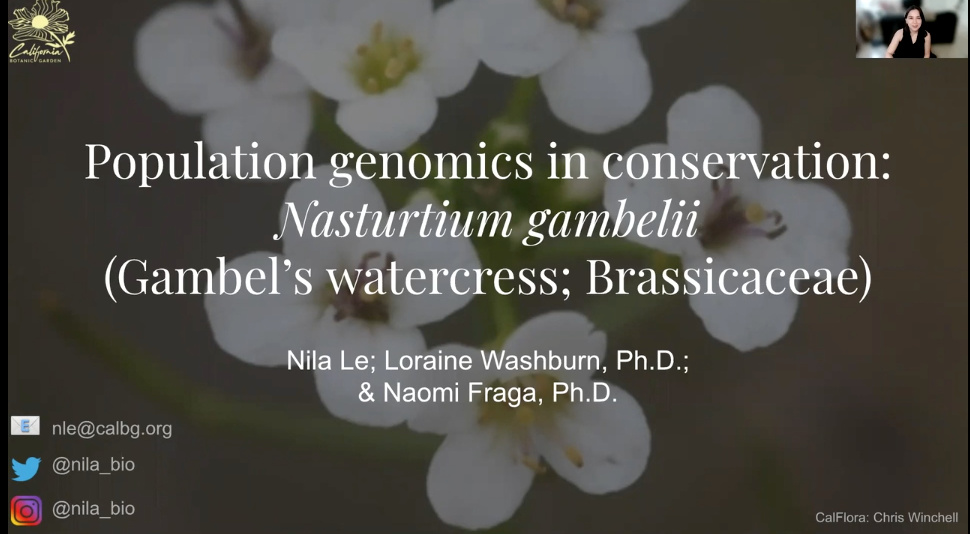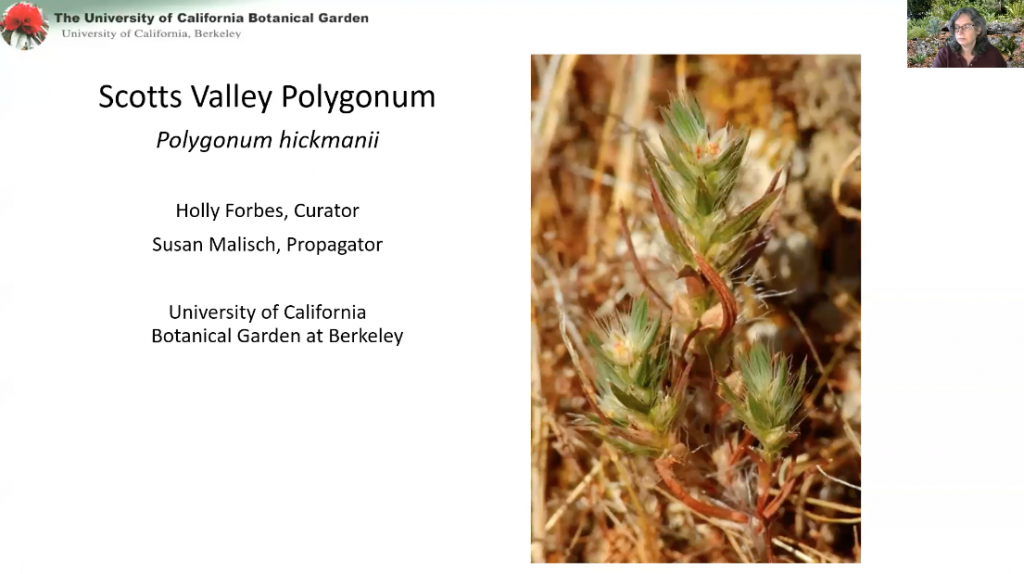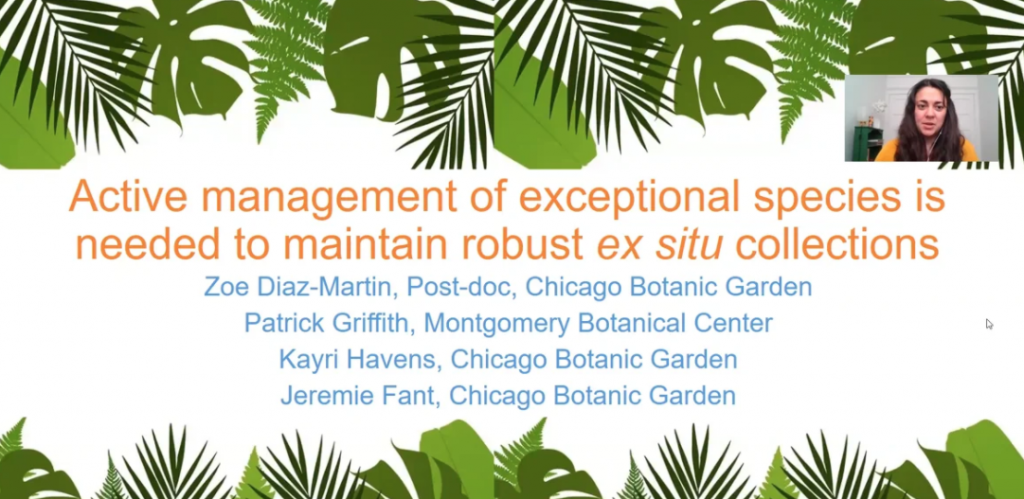
Neusa Steiner, Federal University of Santa Catarina, Emily Coffey, Atlanta Botanical Garden, Jason Ligon, Atlanta Botanical Garden, Lisa Hill, USDA-ARS, Emma Dorr, USDA-ARS, Laurie Blackmore, Atlanta Botanical Garden, Christina Walters, USDA-ARS Torreya taxifolia Arn (Taxaceae) is an ancestral evergreen tree on the brink of extinction. This dioecious plant is found in the Florida panhandle and is threatened by a fungal pathogen. […]
Read More…

Nila Le; Loraine Washburn, Ph.D.; Naomi Fraga, Ph.D., California Botanic Garden Nasturtium gambelii (Gambel’s watercress) is a perennial herb in the mustard family that occurs in wetland habitats in California. It is federally listed as Endangered and currently occurs at only one site, reduced from its historic distribution of just ten sites in coastal southern California. Because […]
Read More…

CPC’s President & CEO Dr. Joyce Maschinski worked with artist and animator Desert Dada to create a general audience animation communicating the importance of plants to creatures great and small. We hope you enjoy. […]
Read More…

Meg Engelhardt, Missouri Botanical Garden As a founding member of the CPC, the Missouri Botanical Garden (MBG) has been seed banking for decades. The seed bank contains three core collections resulting from MBG’s global field programs in plant conservation, horticulture, and ethnobotany. It currently holds over 2,400 accessions of orthodox seeds representing 1,190 different species, of […]
Read More…

Sean Hoban, The Morton Arboretum The world’s botanic gardens and seed banks collectively safeguard millions of plants from more than 100,000 species. However it is not known how many plants should be preserved of each species to conserve genetic diversity and adaptive potential. At The Morton Arboretum, with many collaborators, we have investigated this question over […]
Read More…

Shannon Still, UC Davis The past couple years have been busy and exciting at the UC Davis Arboretum & Public Garden as we became members of Center for Plant Conservation and have been growing our Plant Conservation Program. We are excited to share our progress and where we see the future of our plant conservation […]
Read More…

Holly Forbes, University of California Botanical Garden at Berkeley Polygonum hickmanii (Scotts Valley polygonum) is a small annual species in the buckwheat family (Polygonaceae) restricted to a small area of Scotts Valley, Santa Cruz County, California. Populations have historically occurred across three privately owned properties. Population numbers were critically low in 2009 when the 5-Year Review […]
Read More…

Jennifer Possley, Conservation Program Manager, Fairchild Tropical Botanic Garden South Florida leads the continental US in native fern diversity, with about 60 taxa. Despite this distinction, the region’s ferns have been under-documented and largely ignored by botanists, managers, and regulators. Some of the barriers toward documenting, studying and conserving ferns include difficulties in identification and […]
Read More…

Todd Bittner, Cornell Botanic Gardens Improving our understanding of how abiotic factors affect rare wetland plant species is necessary to inform conservation and management efforts. The decline of some rare fen perennials is believed to be related to the transition from open to closed canopy wetlands. To assess the role that light levels has on […]
Read More…

Jennnifer Ramp Neale, Denver Botanic Gardens In the Research & Conservation department at Denver Botanic Gardens, our core motivation is to investigate and explain biodiversity patterns and processes. We connect people with plants in meaningful ways by conducting scientific research, serving as a resource of scientific expertise, and through expanded scientific capacity. In 2020, we moved […]
Read More…

Heather Schneider, Santa Barbara Botanic Garden Jolon Clarkia (Clarkia jolonensis) is an annual wildflower that is endemic to Monterey County, CA. In 2016, the Santa Barbara Botanic Garden initiated a multi-year endeavor to help understand, protect and restore Jolon Clarkia. Field surveys of all documented occurrences revealed that the plant is rarer than previously known and […]
Read More…

Jim Locklear, Lauritzen Gardens Lauritzen Gardens is dedicated to the conservation of plants and the biological diversity they support. Seed banking projects and rare plant surveys are major elements of our conservation program, but the subjects of this work are mostly obscure species growing in remote settings in faraway places. Having an on-site component to our […]
Read More…

Pam Allenstein, American Public Gardens Association American Public Gardens Association and the United States Forest Service are working together to establish living gene banks of tree species at risk. Efforts focus on non-orthodox seeded at-risk taxa native to U.S. forests which cannot be conserved through traditional seed banking methods. Our Tree Gene Conservation Partnership annually […]
Read More…

Zoe Diaz-Martin, Chicago Botanic Garden Are botanic gardens effectively managing populations of exceptional plant species held across collections? Do garden collections represent the amount of genetic diversity that characterizes the in situ population? We explore these questions in the rare palm Attalea crassispatha, an exceptional species endemic to Haiti with fewer than 50 individuals found […]
Read More…

Emily Grave, Laukahi: The Hawaiʻi Plant Conservation Network Goals to conserve global biodiversity are achieved when local efforts coalesce around specific measurable objectives. The Laukahi Network is implementing the Hawaiʻi Strategy for Plant Conservation (HSPC) following the framework of the Global Strategy for Plant Conservation and adopting the targets most relevant to our needs. The HSPC […]
Read More…

















